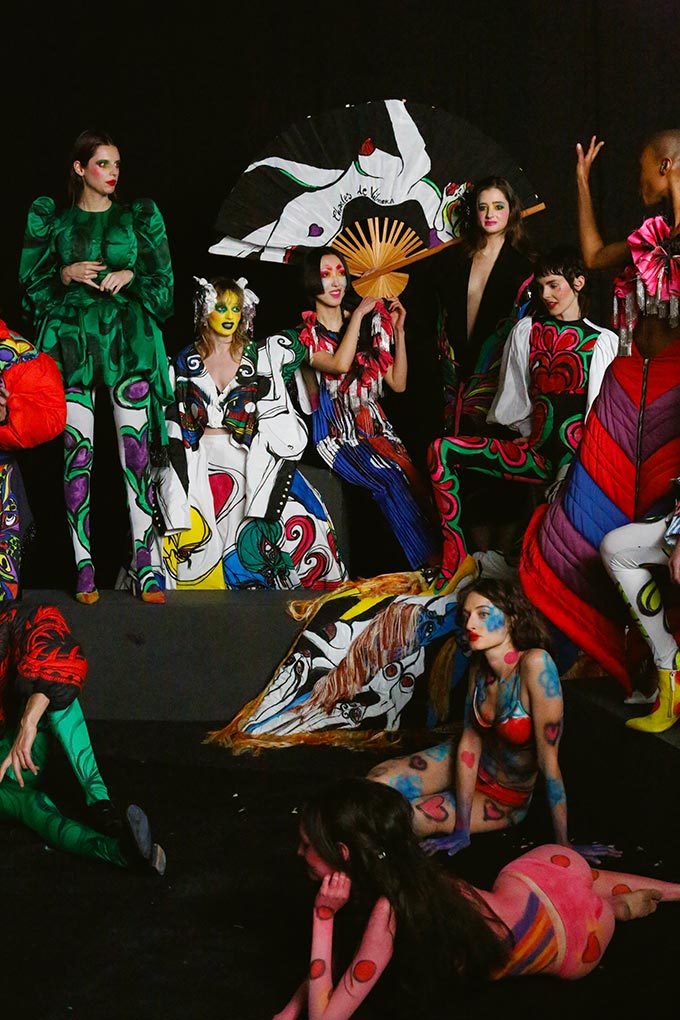Peruse the SS21 couture schedule and you’ll notice an exciting new name among the line-up of storied maisons such as Christian Dior and Chanel: Charles de Vilmorin. If you aren’t already familiar with his name, you soon will be. The 24-year-old is one of the youngest designers to be invited to show on the prestigious and notoriously impenetrable haute couture calendar.
De Vilmorin made the bold decision to launch his namesake label on Instagram during France’s first lockdown in March 2020. The risk paid off and his uplifting, poetic, and delightfully graphic clothing immediately caught the attention of the global fashion press. What’s more, his invitation on to the couture calendar is a signifier that haute couture is on the precipice of change. “For me, couture is not only about luxury—it’s about fantasy and I want to show something out of the ordinary,” says the French designer. “I’m not working like big brands. I want to stay independent and create bespoke experiences.”

With a made-to-measure business model that focuses on genderless clothing, de Vilmorin is representative of gen-Z’s inclusive and eco-conscious mentality. “Gender-specific clothes don’t feel relevant anymore,” he says. An avid illustrator and recent graduate of École de la Chambre Syndicale de la Couture Parisienne, he artfully brings his sketches to life in his freedom-inspired debut collection through larger-than-life silhouettes, psychedelic colour palettes and painting directly on to the skin, turning the face and body into a canvas.
Ahead of the release of his collection film, Vogue caught up with the young designer over Zoom to talk sustainability, genderless design and the future of haute couture.
How did your interest in fashion and clothing come about?
My grandmother and great grandmother designed wedding dresses, which made my family sensitive to art and fashion. Clothing has always been a topic of conversation for us, so it came naturally to me.
Who were your creative influences growing up?
John Galliano made me want to create clothes, Christian Lacroix for the colours and Alexander McQueen for the desire to tell stories. I was also inspired by [filmmaker] Tim Burton and [painters] Chagall, Matisse and Dalí, all artists with dreamlike and poetic worlds.

Where did the idea come from to put illustrations on clothes?
Drawing is the first part of my creative process—I’ve been doing it since I was a child. I’m crazy about prints, so I love putting my drawings on fabric. All of my pieces feature drawings by hand.
What was it like to study at the École de la Chambre Syndicale de la Couture Parisienne?
When I started, it was difficult because no one understood my free approach—it doesn’t follow the regular creative process they try to teach. From my second year onwards, teachers became understanding. I learned to adapt, and to allow people to adapt to me as well.

Why did you launch your debut collection during the first lockdown?
I didn’t think too much about it as it’s always been my goal and the opportunity came up so I couldn’t resist. It made sense for me to launch then because the world was in such a dark place and I wanted to bring colour and joy to everyone.
What ideas have you explored in your SS21 couture collection?
It’s a continuation from my first collection and the theme is freedom. I wanted lots of colours, symbols of liberation illustrated on to the fabric, as well as presenting on different body types. I created dresses, shirts, tights, down jackets and fabric flowers in hairpieces.
The concept of freedom [plays out] in the pattern, such as dresses with big chests that are reminiscent of Niki de Saint Phalle’s women, plus butterfly details in the painting and silhouette, which remind me of flying. I wanted a crushed effect, so I painted on silk with acrylic and Chinese ink.

Who did you collaborate with on the film and what will it look like?
Manon Engel and Alma de Ricou of Studio L’Étiquette shot the film. I also collaborated with MAC on the makeup and body paint, which is extremely colourful. Makeup has always been important in my creative process, I love to express something through a face.
The video, like the collection, speaks on the topic of freedom and is experimental. The looks are staged in the form of paintings that have come to life. The cast are my close friends who’ve been there since the beginning — we’re a small community of like-minded artists.
Why are genderless clothes important to you?
Now that society is evolving, it shouldn’t be about men and women needing to dress in any particular way. If men want to wear dresses, they should be able to. Fashion weeks becoming more mix-gendered is super positive.

You’re one of the youngest designers to join the official couture schedule—how does that feel?
I was a little scared at the beginning because I put a lot of pressure on myself and it was quite overwhelming. Eventually, I just let go and started working hard, which helped me stop overthinking my process and what other people thought.
How do you hope to engage younger people with couture through your work?
By offering more content. [I want to] create a fantasy that is wearable in styles that are relatable to a younger generation. I use Instagram as a way to connect with the younger community.

Do you have ambitions of helming a fashion house or do you plan to focus on your own brand?
To be the creative director at a French house is the dream, but, of course, I want to grow my brand as much as possible.
What do you hope for the future of the fashion industry?
Fashion needs to think more about eco-friendly practices, the impact of climate change and less about making money. I produce clothes on demand, which I feel is the most sustainable approach. We have to adjust our attitude about making and buying fashion for the sake of the environment.





